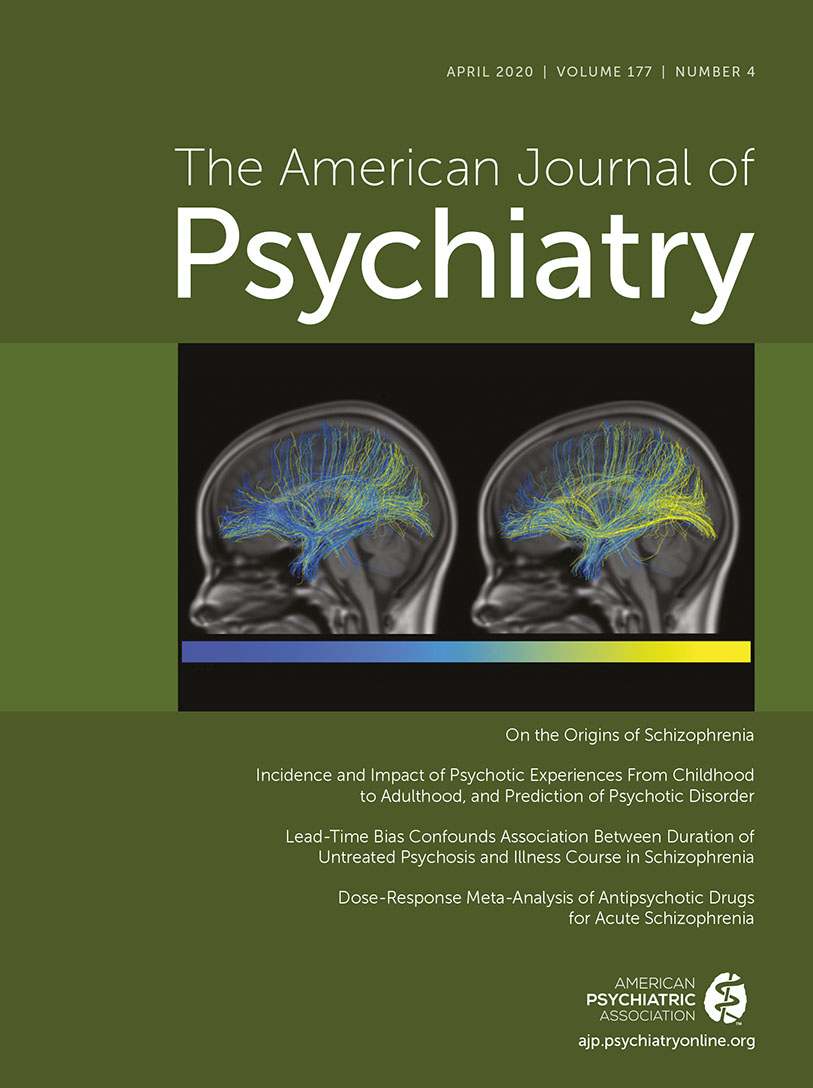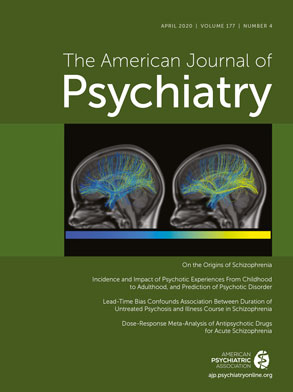Jonas and colleagues (
1) have contributed a valuable and provocative new perspective on the relationship between duration of untreated psychosis (DUP) and clinical course in schizophrenia. A long DUP consistently has been associated with poorer response to medication and with a range of unfavorable clinical outcomes (
2). Despite uncertainty as to whether this association is causal, the link between treatment delay and poor outcomes has been an impetus for the development of early detection strategies. In support of a causal relationship, some evidence suggests that psychosis may have a deleterious effect on the brain and that early initiation of treatment improves outcomes by protecting against a putative “neurotoxic” effect of psychosis (
3–
5). However, it is also possible that individuals with a poor-prognosis form of the illness may have a longer DUP due to insidious onset, apathy, and lack of insight—in other words, illness features that are associated with poor outcome may also be associated with a delay in seeking or receiving treatment. These have been the two standard explanatory models prior to the present article by Jonas and colleagues.
Jonas and colleagues analyzed data from their landmark Suffolk County Mental Health Project, a longitudinal study that included 287 individuals with schizophrenia who were initially enrolled at the time of first hospitalization and assessed after 6 months, 2 years, 4 years, 10 years, and 20 years. Using a multilevel spline regression model, the authors found a steady decline in global functioning that started before the onset of psychosis and continued unabated for the 20 years of follow-up. Their analysis suggests that a long DUP was associated with poor outcomes not because treatment was less effective if started later but because individuals with a long DUP were further along in the course of their deteriorating illness. The timing of treatment initiation did not influence this downward trajectory. Based on this interpretation, the purported misattribution of clinical outcomes to DUP may be an example of “lead-time bias,” a confounding effect that is quite familiar to epidemiologists.
This alternative explanation provides a new framework for analyzing outcomes in early psychosis and identifies a potential problem with the interpretation of results of some previous studies. However, we should not embrace uncritically the conclusions that current treatments may neither protect the brain when given early nor alter the trajectory of illness, nor should we accept as inevitable the proposed model of a uniformly deteriorating course.
One issue that complicates all models of schizophrenia is the great heterogeneity in symptoms and clinical course. This heterogeneity is illustrated by the extreme scatter of data points in Figure 3 in the article by Jonas and colleagues, which indicates just how difficult it is to represent functional outcomes by a single trajectory in such a highly variable and complicated illness. Until we better understand the biological and environmental factors that moderate clinical course, we must exercise caution in making predictions about prognosis or decisions about optimal treatment approaches based on the analysis of heterogeneous populations.
Jonas and colleagues offer the novel insight that, when interpreting the potential effect of DUP on clinical course, it matters whether one aligns individual outcome trajectories according to the time of onset of psychosis as opposed to aligning outcomes according to the time of first treatment. Having aligned trajectories according to onset of psychosis, they found a steep downward slope in functional status starting 6 years prior to onset of psychosis, whereas a previous analysis of the same sample aligned outcomes by treatment onset and found that mean ratings of global functioning remained stable following initiation of treatment until the year 10 assessment (
6). Moreover, the recent Recovery After an Initial Schizophrenia Episode (RAISE) Early Treatment Program study of coordinated specialty care in first-episode psychosis found not just stabilization but steady improvement in functioning over the 2-year follow-up period after initiating treatment (
7). Other studies have found improved functioning 7 years after initiation of treatment (
8) and a maximal remission rate after 7.5 years (
9). It is hard to reconcile the steep downward trajectory reported by Jonas and colleagues with the previous observation that participants in the Suffolk County Mental Health Project remained stable for an extended period after initiating treatment and with observations that participants in other samples improved over an extended period.
A likely explanation for these disparate findings is related to the fact that participants in the Suffolk County Mental Health Project deteriorated in their level of functioning before treatment initiation and again, on average, starting 10 years after treatment initiation (
7). Because the timing of this extended period of stability differed between patients due to differences in how long treatment was delayed, and because the trajectory was modeled based on linear assumptions, the early and late deterioration phases largely determined the common downward slope. Hence, the straight downward trajectory poorly reflects individual trajectories of most participants. We have run simulations and found that a data-generating mechanism in which variable DUP is negatively associated with a treatment response lasting an average of 10 years followed by deterioration produces a trajectory with a steep negative decline that does not capture the effect of treatment or of treatment delay, similar to the finding by Jonas and colleagues.
It is worth noting that another naturalistic longitudinal study that relied on retrospective chart review of 80 individuals with schizophrenia engaged in continuous outpatient treatment in Italy found that DUP was negatively associated with general functioning after a mean of 25 years, whereas duration of illness was not (
10). This study illustrates how sample selection may also affect estimates of the relative associations of DUP and duration of illness with clinical course, but given the retrospective design and lack of standardized assessments, the results must also be interpreted with caution.
Although the single downward trajectory modeled by Jonas and colleagues may not reflect the typical pattern of patients with early psychosis during an extended period after starting treatment, it may accurately reflect outcomes during late stages of the illness during which the Suffolk County Mental Health Project sample experienced functional decline. This raises the questions of why functional status might deteriorate years after initiation of treatment and why DUP might not influence this late deterioration. There are several possible explanations for a delayed deterioration effect, including a failure of treatment, a delayed degenerative component of the illness, or a delayed toxic effect of medication. The Suffolk County Mental Health Project has been cited as an example of the inadequate treatment provided to people with psychotic illness in the United States; half of participants in the sample did not receive consistent pharmacologic care (
11). If psychotic relapse occurs because of inadequate treatment or treatment nonadherence, psychotic relapse may exert a negative effect similar to the effect of DUP that occurs prior to initiation of treatment. In other words, untreated psychosis at any stage of illness may count as additional DUP in terms of impact on clinical course. Studies have linked cumulative duration of relapse to poor outcomes (
12) and brain atrophy (
13) and have shown that response to treatment diminishes after psychotic relapse (
14), supporting the model in which treatment is viewed as protecting the brain against adverse effects of psychosis. Alternatively, a subgroup of poor-prognosis patients who minimally benefit from treatment or who experience late-stage deterioration regardless of treatment might obscure a longer-term benefit of early intervention for individuals whose symptoms respond to treatment. If medication is contributing to a delayed deterioration in some patients, this also requires study so that therapeutic approaches can be tailored for this possible subgroup (
5,
8).
In conclusion, if a potential long-term benefit of early intervention is to be realized, attention must be focused on preserving the initial benefits of treatment over the lifespan. The current focus of research and allocation of clinical resources to the early stages of illness may have minimal impact on the dispiriting downward trajectory identified by Jonas and colleagues unless late-stage deterioration is also addressed and high-quality treatment is provided beyond the early years of illness. Because ethically we cannot randomly assign individuals to a long or short DUP, we do not have definitive evidence with which to answer questions about the clinical consequences of early intervention; conclusions based on any single study must be tempered. Although the potential relationships of DUP, early intervention, and longer-term outcomes remain unclear, Jonas and colleagues have called attention both to a potential bias in current analytic approaches to the study of DUP and to the importance of considering the long-term course of illness when evaluating interventions that we hope will change the trajectory of illness.

